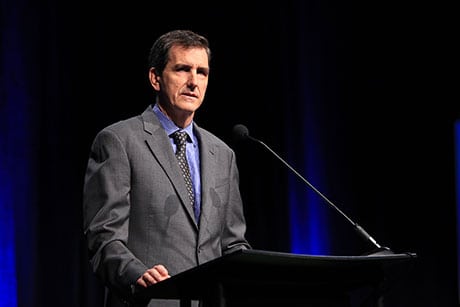 |
| Michael Whitaker, deputy administrator and chief NextGen officer at the FAA. Photo: ATCA |
[Avionics Today 09-19-2014] There’s a long road ahead, but nothing will get in their way. That was the sentiment at the NextGen Institute’s public forum yesterday in which speakers from the FAA and private sectors discussed the goals and shortcomings of NextGen implementation.
The NextGen Institute, a public-private partnership between the FAA and the National Center for Advanced Technologies (NCAT), addressed, at its public forum entitled “Achieving Gains, Building the Future,” issues related to the Automatic Dependent Surveillance – Broadcast (ADS-B) implementation mandate set for 2020, as well as the roles Unmanned Aircraft Systems (UAS) will play in in that mandate, among other topics.
Michael Whitaker, the deputy administrator and chief NextGen officer at the FAA, opened the forum by addressing the progress the program has seen in the last year.
“NextGen is a 20 year, $20 billion endeavor and we’re $5 billion in, so it’s still relatively early in the long haul,” Whitaker said, referring to the money that’s already been spent on NextGen programs equipage such as ADS-B, Data Communications (Data Comm), National Airspace System Voice System (NASVS), and System Wide Information Management (SWIM). “But we are on track for the completion of the foundational pieces of the program.”
The FAA has spent much of the last year building ground structures for terrestrial ADS-B to prepare for when NextGen implementation comes around, conducting research to figure out the best way to forge ahead and reworking airport procedures, from which the largest gains can be seen.
“We introduced 61 new satellite-based procedures in the Houston area to reduce distances flown by as much as 650,000 nautical miles each year in the United States because of the redesign, that’s equivalent to taking 6,000 cars off the streets,” said Whitaker. “There have been new runway procedures in Atlanta that have significantly increased passengers and the new procedures have been hugely popular with carriers to increase runway capacity.”
And while time was spent highlighting the gains made in with NextGen procedures, the conversation quickly turned toward the challenges the troubled and highly criticized program has faced in the past and how those involved are looking to mitigate these issues as it maps out the road ahead. At the forefront of these issues is the budget.
“We’re somewhat at the mercy of the funding process,” said Whitaker, who admitted that the lack of long-term visibility makes future programs uncertain and unstable. The FAA’s Assistant Administrator for NextGen, Edward Bolton, Jr., added to the budgetary uncertainty by noting that the funding necessary to complete the program is $2 billion short. Current levels of funding allow just enough room for the FAA to move forward with the base programs of NextGen; Bolton hopes to capitalize on this short road ahead by demonstrating that, this time, the FAA means business.
“By saying you’re going to do something and doing exactly what you’ve said, demonstrating that you’re capable of carrying it out, that’s the best way to achieve more stable funding,” said Bolton.
And one of the areas where the FAA promises to keep its word is the 2020 ADS-B mandate.
“One of our main initiatives is communicating that the 2020 date is not going to change,” said Whitaker, who set out to demystify the myth that the date would be pushed back.
But, although the timeline might remain the same, the exact terms of the mandate are unclear, particularly in regards to whether UAS — large or small — will need to be equipped with ADS-B capabilities, and how that can be done. With Google’s unveiling of Project Wing, a low-flying, commercial use delivery UAS, and similar projects by Amazon and other non-aviation companies, UAS becomes a more pressing and challenging issue to tackle.
“Thirteen years ago things like UAS weren’t really part of the equation,” said Whitaker, noting the changing landscape of NextGen. “But it’s difficult to see how we wouldn’t use ADS-B to tackle the problems of integrating larger UAS into air traffic.” He continued to note that certain issues with UAS such as sense and avoid and Air Traffic Control (ATC) would have to be tackled first.
FAA officials aren’t being shy about the uncertainty of the NextGen program as well as the program’s numerous shortfalls, but the FAA and private partners are forging ahead nonetheless.
“It will not be easy. It will not go perfectly. There will be problems and setbacks, but we’ll get it done,” said Bolton.